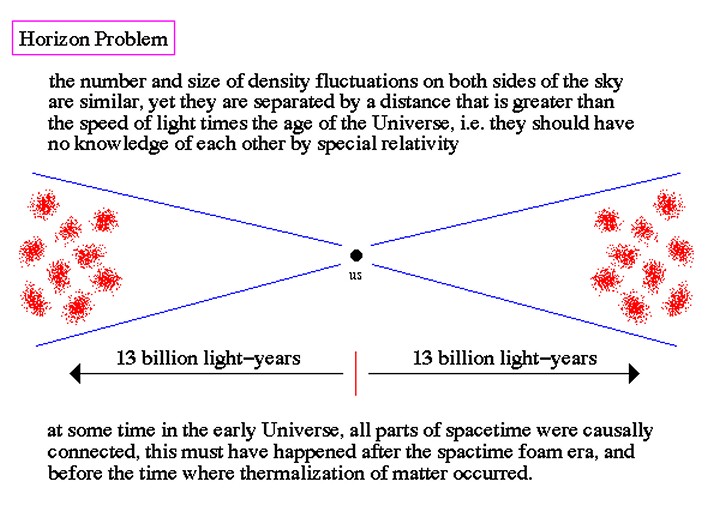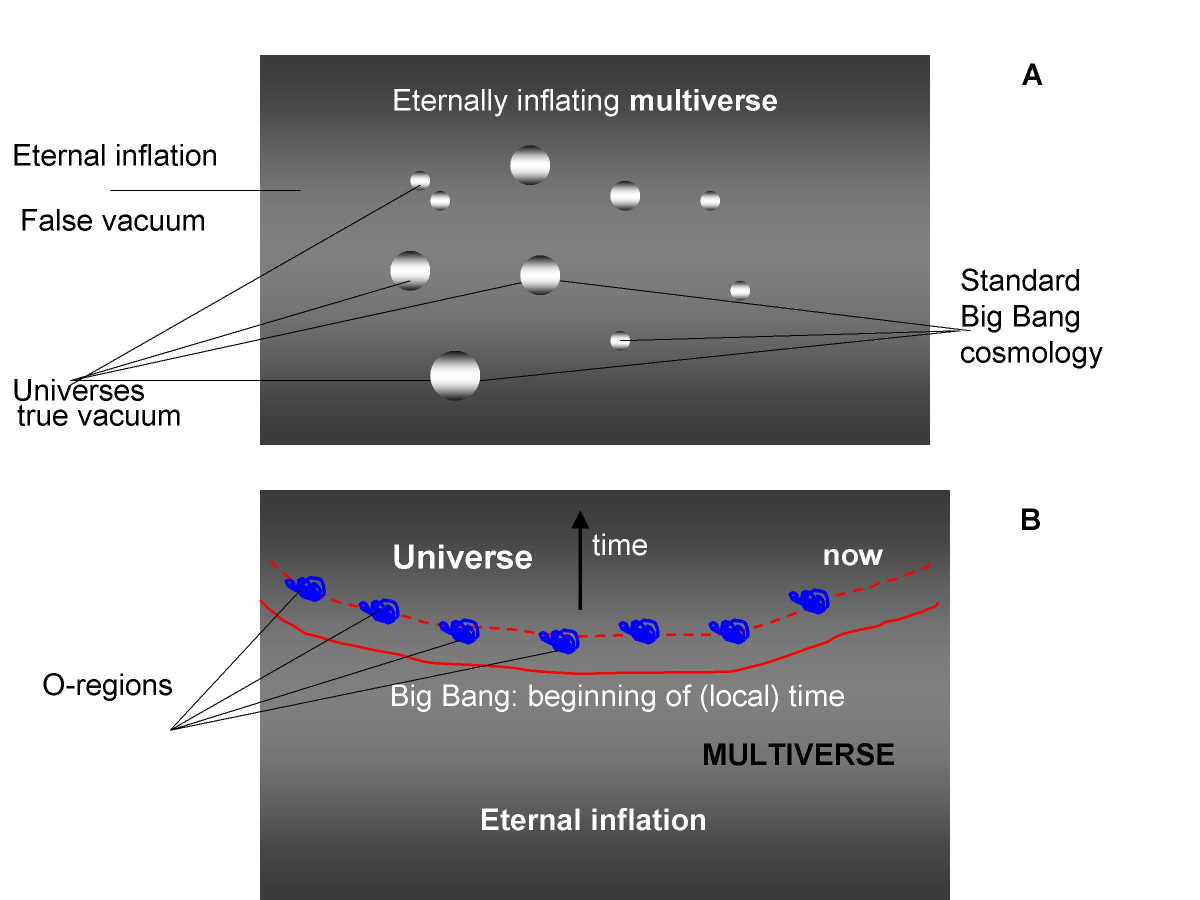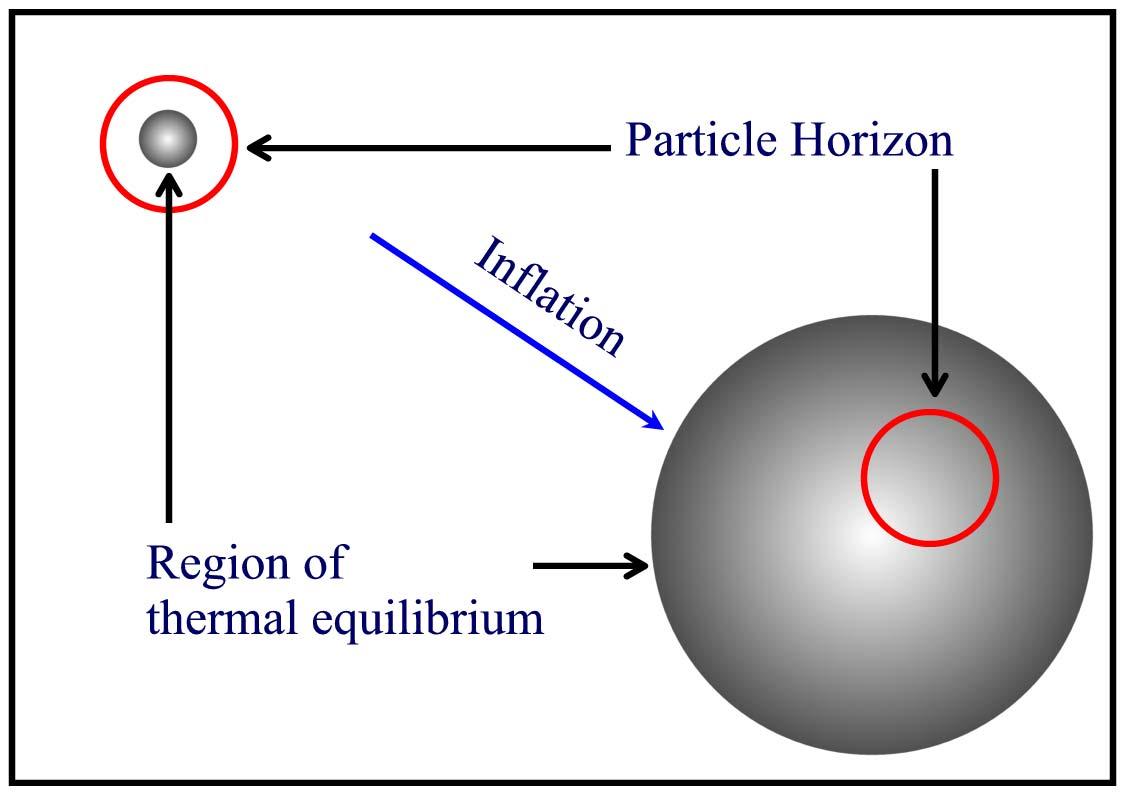The Inflationary Universe
Now and then, I mention perplexing facts about the Universe.
I will now go into two of them in more detail and offer an
explanation (perhaps).
 |
Flatness Problem
The Universe has total Omega = 1.
Is this a problem? Yes.
To understand this point, recall that the Universe is fairly old,
13.7 billion years and that Omega = 1 is for a
critical
Universe.
Analogy: Try and balance a pencil on its pointed end. If you
are far from vertical, the pencil falls to the ground very quickly. The closer
you can place the pencil to vertical the longer it stands-up before it
falls over. If you could place it at precisely vertical then (classically) it
could stand-up forever. It is hard to place the pencil at its critcal
position.
Universe: If the Universe started off far from critical, then it would
have either quickly collapsed (not lasted for 13.7 billion years) or it would
have expanded so quickly that it would have passed through the nucleosynthesis
and galaxy formation epochs so fast that we would not be here. The only way for
the Universe to have lasted this long and to have passed through the
nucleosynthesis era at leisurely enough rates requires that the Universe
started off very
close to critical. How close?
Amazingly,
Omega must be 1 during the Planck Era to within 60 digits or so
to make Omega(t) ~ 1 today.
This is Flatness Problem.
|
 |
Horizon Problem
The horizon problem arises because light moves with a finite speed.
As a result, certain events which occur in the Universe are completely
independent of each other,
The current Universe has a horizon distance of
horizon ~ age x speed of light
===> the older the Universe is, the larger the horizon and therefore the
larger the size of the region which can communicate.
A simple calculation indicates that at the time of recombination, material
which was in causal contact (able to communicate) are currently
separated by around 0.8 angular degrees on the sky.
this means that the sky could only mix over separations of
0.8 degrees
and so, there is no rational reason to believe that the sky should look the
same everywhere! This is the
Horizon Problem.
|
The above mysteries may be explained by what is
known as the Inflation Theory
. Recently results from the
Wilkinson Microwave Anisotropy Probe (WMAP) offered strong support
for the Inflation theory. To get a handle on
inflation
recall that the nature of the four forces of nature changes
as the Universe evolves:
At earlier and earlier times, the way matter, radiation, and the
Universe interact gets simpler and conversely, as the Universe
evolves, the way matter, radiation, and the Universe interact
get more complicated. Where the forces of the
Universe get more complicated are referred to as
The symmetry breakings are analogous to
phase transitions (e.g., liquid water ---> solid water (ice),
liquid water ---> vapor, etc.).
The GUTs era, when the symmetry breaking for the
nuclear (strong) and electro-weak
forces happened. This is when inflation occurred.
Inflation is driven by a nonzero Cosmological constant; ah ha, there must be
one but it must be reasonably small (fine-tuning) and it must disappear (or
become very small) as the
Universe evolves.
During inflation, the scale factor of the Universe evolves as:

Inflation causes the Universe to increase in size greatly and to
cool rapidly. At the end of the rapid expansion, the Universe re-heats
and then continues on its normal evolution. The inflation
does not affect the long-term evolution of the Universe; it is
needed only to cause a rapid blow-up in size of the Universe at an
early time.
What are some consequences of this blow-up?
- For typical models, the Universe
roughly doubles in size every ~ 10-34 seconds
This is a phenomenal
rate, e.g.,
- t = 0 sec ---> 10-24 cm
- t = 10-34 sec ---> 2 x 10-24 cm
- t = 2 x 10-34 sec ---> 4 x 10-24 cm
- t = 3 x 10-34 sec ---> 9 x 10-24 cm
- ...
- t = 100 x 10-34 sec ---> ~ 13 km
In the example, the Universe grows by a factor of more than 1030
in 10-32 sec. The exact rate at which the Universe grows depends
on the particular model. The point is that the expansion rate is humongous!
(Note that in this example, the Universe expands with speed >> c!)
- Horizon Problem
Suppose that we start with a large universe and consider a small causally
connected chunk say, of size 10-23 cm. Suppose the Universe
inflates and that inflation lasts for 10-32 sec,
The causally connected chunk of the
Universe expands to a size 107 cm. This
inflated patch easily encompasses our Universe which, at this time, is
only ~ 30 cm in size. Our Universe was embedded in this huge
region which was causally connected before inflation,
This explains the horizon problem.
- Flatness Problem
The Earth is known to be spherical, however,
for us small (short people) living on
the surface of the Earth, the Earth appears flat. It appears flat because we are
not tall enough to see over the edge of the Earth.
Due to inflation, we have
Inflation predicts that the Universe should appear flat
(that is, Omega = 1, identically). This resolves the
flatness problem.
 | Eternal Inflation
As the Universe inflates, the
false vacuum material starts to decay. The part that decays settles into
normal matter which form Pocket Universes. The remaining
false vacuum material continues to grow rapidly, inflation continues. This
kind of an argument suggests that inflation conitunues into the future
indefinitely, spawning infinite numbers of Pocket Universes in its
wake. |
Return to Lecture 6






